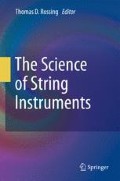Abstract
Scientifically speaking, the Hutchins–Schelleng violin octet is the most interesting of all the bowed string instruments. We refer specifically to those instruments resulting from the first application of physics to the design of bowed string instruments, viz., the scientific resonance scaling process developed by John Schelleng to dimension the violin – certainly the most “successful” and mature bowed string instrument – to cover a 3½ octave range.
Access this chapter
Tax calculation will be finalised at checkout
Purchases are for personal use only
References
Bissinger G (1992a) “Semiempirical relationships for A0 and A1 cavity mode frequencies for bowed string instruments of the violin, viola and cello family” Catgut Acoust. Soc. J. (series II) 2(1), 8–12.
Bissinger G (1992b) “The effect of violin cavity volume (height) changes on the cavity modes below 2 kHz” Catgut Acoust. Soc. J. (series II) 2(2), 18–21.
Bissinger G (1996). “Acoustic normal modes below 4 kHz for a rigid, closed violin-shaped cavity” J. Acoust. Soc. Am. 100, 1835–1840.
Bissinger G (1998) “A0 and A1 coupling, arching, rib height, and f-hole geometry dependence in the 2-degree-of-freedom network model of violin cavity modes” J. Acoust. Soc. Am. 104, 3608–3615.
Bissinger G (2003a) “Wall compliance and violin cavity modes” J. Acoust. Soc. Am. 113, 1718–1723.
Bissinger G (2003b) “Modal analysis of a violin octet” J. Acoust. Soc. Am. 113, 2105–2113.
Bissinger G (2005) “A unified materials – normal mode approach to violin acoustics” Acta Acustica/Acustica 91, 214–228.
Bissinger G (2007) “Surprising regularity between plate modes 2 and 5 and the B1 corpus modes: Part I” J. Violin Soc. Am. VSA Papers 21, 83–101.
Bissinger G, Hutchins CM (1988) “A1 cavity-mode-enhanced fundamental in bowed violin and viola sound” Catgut Acoust. Soc. J. (series II) 1(2), 11–13.
Bissinger G, Rowe D (2007) “Three-dimensional normal mode vibration plus acoustic analysis of two exemplary old Italian violins (abstract)” J. Acoust. Soc. Am. 121, 3061.
Bissinger G, Williams EG, Valdivia N (2007) “Violin f-hole contribution to far-field radiation via patch near-field acoustical holography” J. Acoust. Soc. Am. 121, 3899–3906.
Hutchins CM (1967) “Founding a family of fiddles” Phys. Today 20(2), 23–37.
Hutchins CM (1976) “The Helmholtz air resonance of the cello and baritone” Catgut Acoust. Soc. Newsl. 26, 5–6.
Hutchins CM (1986). “Free plate tuning frequencies for the violin octet instruments” J. Catgut Acoust. Soc. 45, 12–14.
Hutchins CM (1992a) “A 30-year experiment in the acoustical and musical development of violin-family instruments” J. Acoust. Soc. Am. 92, 639–650.
Hutchins CM (1992b). “The future of violin research” Catgut Acoust. Soc. J. (series II) 2(1), 1–7.
Hutchins CM, Schelleng JC (1967) “A new concert violin” J. Audio Eng. Soc. 15, 4–6.
Jansson E (1973) “On higher air modes in the violin” Catgut Acoust. Soc. Newsl. 19, 13–15.
Jansson E (1977) “Acoustical properties of complex cavities: prediction and measurements of resonance properties of violin-shaped and guitar-shaped cavities” Acustica 37, 211–221.
Jansson E, Sundin H (1974) “A pilot study on coupling between top plate and air volume vibrations” Catgut Acoust. Soc. Newsl. 21, 11–15.
Knott GA (1987) “A modal analysis of the violin using the MSC/NASTRAN and PATRAN”, MS thesis, Naval Postgraduate School, Monterey, CA.
Marshall KD (1985) “Modal analysis of a violin” J. Acoust. Soc. Am. 77, 695–709.
Saunders F (1953) “Recent work on violins” J. Acoust. Soc. Am. 25, 491–498.
Schelleng J (1963) “The violin as a circuit” J. Acoust. Soc. Am. 35, 326–338 (erratum, p. 1291).
Schleske M (1996) “Eigenmodes of vibration in the working process of a violin” Catgut Acoust. Soc. J. (series II) 3(1), 2–8.
Shaw EAG (1990) “Cavity resonance in the violin: network representation and the effect of damped and undamped rib holes” J. Acoust. Soc. Am. 87, 398–410.
Spear R (2003) “Influence of form on the signature modes of a second-generation new violin family quintet” Catgut Acoust. Soc. J. (series II) 4(8), 19–24.
Acknowledgments
My contribution to violin octet research discussed here owes much to the active support of Carleen Hutchins who loaned me a complete octet for modal testing and the National Science Foundation who funded the materials-dynamics approach embodied in VIOCADEAS. I also want to acknowledge discussions with Robert Spear concerning the present and future status of the violin octet.
Author information
Authors and Affiliations
Corresponding author
Editor information
Editors and Affiliations
Rights and permissions
Copyright information
© 2010 Springer Science+Business Media, LLC
About this chapter
Cite this chapter
Bissinger, G. (2010). The Hutchins–Schelleng Violin Octet After 50 Years. In: Rossing, T. (eds) The Science of String Instruments. Springer, New York, NY. https://doi.org/10.1007/978-1-4419-7110-4_18
Download citation
DOI: https://doi.org/10.1007/978-1-4419-7110-4_18
Published:
Publisher Name: Springer, New York, NY
Print ISBN: 978-1-4419-7109-8
Online ISBN: 978-1-4419-7110-4
eBook Packages: Physics and AstronomyPhysics and Astronomy (R0)

